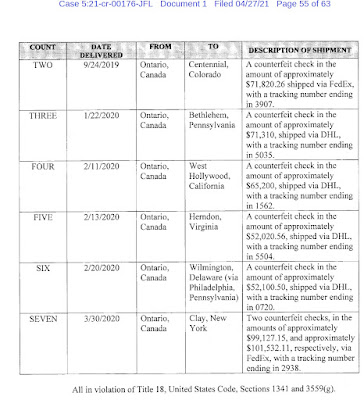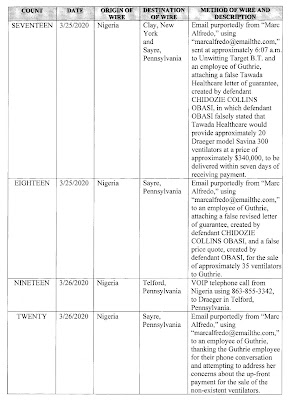TL;DR? Good news! I read them for you!
On 15SEP2022, the Department of Justice released their report "The Role of Law Enforcement in Detecting, Investigating, and Prosecuting Criminal Activity Related to Digital Assets" (66 pages). The first of the nine reports ordered by President Biden's Executive Order 14067 "Ensuring Responsible Development of Digital Assets" was also released by the DOJ back on 06JUN2022, "How To Strengthen International Law Enforcement Cooperation for Detecting, Investigating, and Prosecuting Criminal Activity Related to Digital Assets" (58 pages).
Since then, we have seen the Department of Treasury release three reports:
Treasury also provided to the White House in July a "
Framework for International Engagement on Digital Assets" which is described in their press release, but not provided to the public.
Earlier this month, the Department of Commerce released their report:
"
Responsible Advancement of US Competitiveness in Digital Assets" (19 pages).
The Office of Science & Technology Policy also released three reports:
In this blog post, we'll focus on the two DOJ reports, which we will address in the reverse order of their release, as it seems that it is required to define the role of law enforcement in digital assets before discussing the international cooperation one would seek in this area.
The Role of Law Enforcement in Digital Assets
Despite the Executive Order, it is important to note that the Department of Justice did not need the urging of the White House to establish procedures for addressing Cryptocurrency. The department created the Attorney General's Cyber-Digital Task Force in 2018, which produced their original report, published in October 2020, titled the
CryptoCurrency Enforcement Framework (83 pages). That original report characterized the illicit uses of cryptocurrency into three broad categories of criminality:
- financial transactions associated with the commission of crimes, such as buying and selling drugs or weapons, leasing servers used in the commission of cybercrime, soliciting funds to support terrorist activity, or ransom, blackmail and extortion.
- money laundering and the shielding of legitimate activity from tax, reporting, sanctions, or other legal requirements, including operating unlicensed, unregistered, or non-compliant exchanges.
- crimes, such as theft, directly implicating the cryptocurrency marketplace itself, such as stealing cryptocurrency from exchanges or defrauding unwitting investors.
The original report listed many case studies involving indictments, seizures, and arrests in the scenarios above, including SamSam ransomware, Welcome to Video and DarkScandals child sexual abuse services, terrorist funding both through direct donation and via sales of fake medical equipment (PPE during COVID), the Bitcoin Maven case (Theresa Tetley), BTC-e, Operation DisrupTOR (Wall Street Market), DeepDotWeb, DreamMarket, the Lazarus group hacks, HeroCoin ATMs, the Helix mixer, and others.
The new report points out something that I've recently been mentioning as well. Bitcoin and other block-chain-based crypto currencies are neither the first digital currency, nor the first one that has facilitated a great deal of criminal trade. The report mentions E-Gold (1996) and Liberty Reserve (2006) as "pre-crypto" examples of digital currencies, but could have as easily mentioned Webmoney (1998) or PerfectMoney (2007). Many of the points of the new report echo of those of the prior, although the cases have been updated, such as Bitfinex, Helix, and Hydra Market, estimated at one point to perform 80% of all darknet market-place transactions, and Garantex, the Estonia-based Exchange that laundered more than $100 million of the funds associated with darknet markets. The Colonial Pipeline ransomware and the use by indicted GRU agents of bitcoin, the theft of $600 Million by Lazarus Group hackers in March 2022 are all used to update the original report.
Two significant additions are the section on the Growth of Decentralized Finance (DeFi) and Non-Fungible Tokens (NFTs). In this area, the discussion of "Decentralized Autonomous Organizations" as opposed to a traditional corporate structure, and the insider trading, money laundering, and tax evasion aspects of NFT trading are discussed. (Examples of Nathaniel Chastain of OpenSea and Ishan Wahi of Coinbase are provided as insider examples.)
Section II of the report discusses DOJ efforts such as the National Crypto Enforcement Team (NCET) and its predecessors such as the Money Laundering and Asset Recovery Section's Digital Currency Initiative, and the Internation Virtual Currency Initiative. A few interesting statistics from the FBI, including that as of July 2022, the FBI had worked 1,100 separate investigations across 100 investigative program categories that involved a digital assets nexus. Since their first digital assets seizure in 2014, the FBI has seized $427 million in virtual assets (as valued at time of seizure.) In February 2022, the FBI created the Virtual Assets Unit. The Department of Justice has also created a Digital Asset Coordinators Network which is composed of designated prosecutors in U.S. Attorney's Offices across the country who work closely with CCIPS, MLARS, and NCET. The program is based on the successful CHIP Network (Computer Hacking and Intellectual Property) and the National Security Cyber Specialist (NSCS) Network which each designate prosecutors in every field office to be specially trained and equipped to handle the relevant case types for their office.
The DEA's Cyber Support Section is described as performing cryptocurrency analysis related to the use of cryptocurrency to facilite drug trafficking, while the US Marshals Service is the group manages and liquidates seized crypto funds. HSI has been a key player in many crypto cases, with at least 500 currently active investigations, especially via their Financial Crimes Unit, Cyber Crimes Center, and Asset Forfeiture Unit. The US Secret Service is also involved, with 302 cases involving digital assets and at least 535 seizures of digital assets valued at more than $113 Million at time of seizure. The US Secret Service is also a top trainer of state and local law enforcement via the National Computer Forensics Institute (NCFI) headquartered here in Hoover, Alabama! They also operate a
Digital Assets Awareness Hub to educate the public on crypto risks.
Regulatory Agencies also play their part, with FinCEN working to enforce Bank Secrecy Act (BSA) guidelines and regulations related to Anti-Money Laundering and Countering Financing of Terrorism (AML/CFT) requirements. Treasury manages the OFAC office, which includes sanctioning mixer and state-sponsored crypto hackers. The SEC regulates crypto scams that are structured as "investment contracts, such as BlockFi Lending LLC or the DeFi Money Market. The Commodity Futures Trading Commission (CFTC) regulates the trade of commodities in interstate commerce. They have brought 50+ enforcement actions against organizations such as Coinbase, Payward Ventures (Kraken), Blockratize (Polymarket).
BitMEX is one cryptocurrency derivatives exchange targeted for CFTC enforcement, after $209 Million in darknet market transactions were cashed out via BitMEX, who paid a $100 Million fine, with three co-founders pleading guilty to criminal charges and paying a $10 million fine.
One last organization of note is IVAN, the Illicit Virtual Asset Notification platform, being built by FinCEN and the FBI's National Cyber Investigative Joint Task Force. The goal of IVAN is to be a public-private information exchange to allow industry to collaborate on timely detection and disruption of the use of virtual assets in furtherance of illicit activity.
Requests for Legislation
The Justice report does make several requests for additional legislation, in five categories:
- extend the prohibition against disclosing subpoenas (currently in effect for financial institutions) to VASPs (Virtual Asset Service Providers), strengthen the laws against operating an unlicensed money transmitting business, and extend the statutes of limitations from 5 to 10 years for certain crimes.
- support for initiatives that would aid investigators in gathering evidence
- strengthening sentencing guidelines for certain BSA violations
- extend BSA record keeping rules to VASPs
- ensuring that law enforcement has resources to conduct and staff sophisticated digital asset-related investigations.
International Considerations
One of the main observations of the report on International Law Enforcement Cooperation is the standard complaint that the Mutual Legal Assistance treaties are too slow, and that faster methods of international law enforcement cooperation, such as the "24-7 Network" often do not have a standard way of sharing requests regarding Virtual Asset Service Providers. (VASPs).
Next, while the western-friendly nations of the world have largely standardized cybercrime laws under the
Budapest Convention on Cybercrime, the way in which the nations of the world define, regulate, and enforce actions against VASPs are varied and inconsistent. Under the concept of Dual Criminality, where one nation may only ask another to enforce laws which are similar in both countries, much of crypto-crime enforcement lacks such standards.
While the Cybercrime laws may not have caught up, the International body that deals with Anti-Money Laundering, FATF or the Financial Action Task Force, are clear thought leaders on the Virtual Assets guidelines. (We wrote about FATF in 2019, please see:
Money Laundering and Counter-Terrorist Financing: What is FATF? ) Unfortunately, as of July 2021, only 35 participating nations had implemented the FATF suggestions regarding virtual assets and VASPs into their national laws.
My favorite part of the "Strengthening International Law Enforcement" report is Annex B: "Examples of Successful Cross-Border Collaboration on Digital Asset Investigations."
Liberty Reserve
BTC-e
Helix
Silk Road
Operation Bayonet (AlphaBay and Hansa)
Dream Market
Wall Street Market
DeepDotWeb
Welcome To Video
Operation DisrupTOR
Hydra Market
Twitter hack
Sodinokibi/REvil Ransomware
NetWalker Ransomware
BitConnect
For each example above, details are shared about which international law enforcement agencies partnered with which US agencies in order to reach the successful resolution. Inspiring reading!







